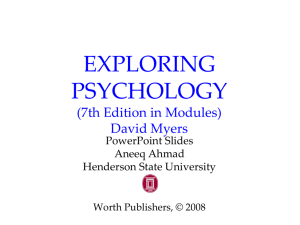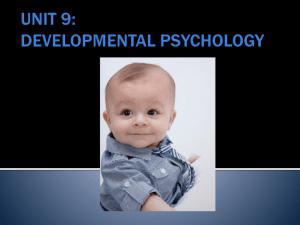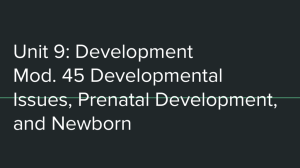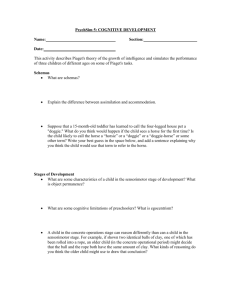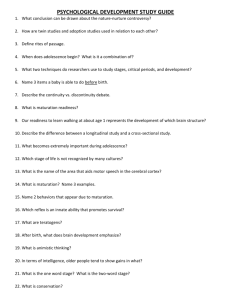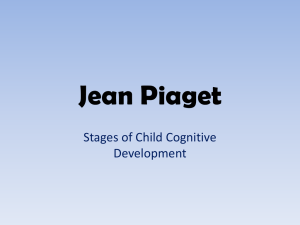Psychology David Myers
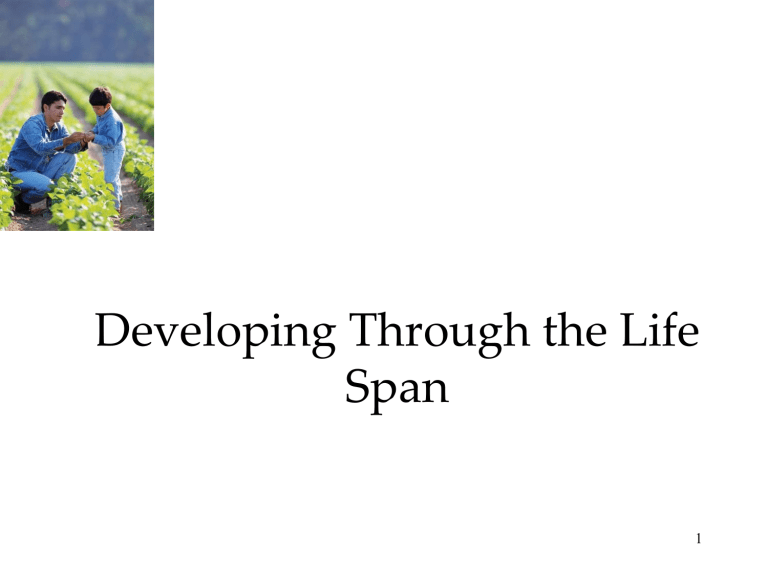
Developing Through the Life
Span
1
Infancy and Childhood
Module 11
2
Physical Development
Brain Development
Motor Development
Maturation and Infant Memory
Cognitive Development
Piaget’s Theory and Current Thinking
CLOSE-UP: Autism and “Mind-blindness”
Reflecting on Piaget’s Theory
3
Social Development
Origins of Attachment
Attachment Differences
Parenting Styles
4
Infancy and Childhood
Infancy and childhood span from birth to the teenage years. During these years, the individual grows physically, cognitively, and socially.
Stage
Infancy
Childhood
Span
Newborn to toddler
Toddler to teenager
5
Physical Development
Brain Development
At birth, most brain cells are present. After, the neural networks multiply resulting in increased physical and mental abilities.
6
Brain Development
The development of the brain unfolds based on genetic instructions, causing various bodily and mental functions to occur in sequence— standing before walking, babbling before talking—this is called maturation .
Maturation sets the basic course of development, while experience adjusts it.
7
Motor Development
First, infants begin to roll over. Next, they sit unsupported, crawl, and finally walk.
Experience has little effect on this sequence.
8
Maturation and Infant Memory
The earliest age of conscious memory is around
3½ years (Bauer, 2002). A 5-year-old has a sense of self and an increased long-term memory, thus organization of memory is different from 3-4 years.
9
Maturation and Infant Memory
Although they may not consciously remember, babies are capable of learning.
3-month-old infants can learn to move a mobile by kicking.
(Rovee - Collier,
1989, 1997.)
10
Cognitive Development
Cognition refers to all the mental activities associated with thinking, knowing, remembering, and communicating.
Developmental psychologist Jean Piaget believed that children reason differently than adults and that a child’s mind develops in a series of stages.
Jean Piaget (1896–1980)
11
Schemas
Piaget felt that the driving force behind our intellectual progression is an unceasing struggle to make sense of our experiences and that to do this maturing brains build schemas.
Schemas are a concepts or frameworks that organize and interpret information.
To use our schemas Piaget proposed that we assimilate new experiences, or interpret them according to our schemas and then adjust or accommodate our schemas accordingly.
12
Infancy and Childhood: Cognitive
Development
Piaget’s Theory and Current
Thinking
14
Sensorimotor Stage
In the sensorimotor stage, babies take in the world by looking, hearing, touching, mouthing, and grasping. Children younger than 6 months of age do not grasp object permanence , i.e., objects that are out of sight are also out of mind.
CD1, #15
15
Sensorimotor Stage: Criticisms
Piaget believed children in the sensorimotor stage could not think —they do not have any abstract concepts or ideas.
However, recent research shows that children in the sensorimotor stage can think and count.
16
Preoperational Stage
Piaget suggested that from 2 years old to about 6-7 years old, children are in the preoperational stage —too young to perform mental operations. For example, in this stage do not understand the concept of conservation, the principle that quantity remains the same despite changes in shape.
This preoperational child does not yet understand the principle of conservation
17 of substance.
Preoperational Stage: Criticism
DeLoache (1987) showed that children as young as 3 years of age are able to use metal operations. When shown a model of a dog’s hiding place behind the couch, a 2½-year-old could not locate the stuffed dog in an actual room, but the 3-year-old did.
18
Egocentrism
Piaget concluded that preschool children are egocentric . They cannot perceive things from another’s point of view.
When asked to show her picture to mommy, 2-yearold Gabriella holds the picture facing her own eyes, believing that her mother can see it through her eyes.
19
Infancy and Childhood: Cognitive
Development
Animism (confusion between physical and psychological events)
Confusion of external, physical objects with internal thoughts; thinking that objects think and feel.
Example: A child is afraid of the
“monsters” in a dark closet and that clouds move “because they’re having fun.”
Theory of Mind
Preschoolers, although still egocentric, develop the ability to understand another’s mental state when they begin forming a theory of mind .
As theory of mind develops, they seek to understand and interpret the actions and feelings of other people.
21
Concrete Operational Stage
In the concrete operational stage , given concrete materials, 6- to 7-year-olds grasp conservation problems and mentally pour liquids back and forth into glasses of different shapes conserving their quantities.
Children in this stage are also able to transform mathematical functions. So, if 4 + 8 = 12, then a transformation, 12 – 4 = 8, is also easily doable.
22
Formal Operational Stage
Around age 12, our reasoning ability expands from concrete thinking to abstract thinking. We can now use symbols and imagined realities to systematically reason.
Piaget called this formal operational thinking.
Rudiments of such thinking begin earlier (age 7) than what Piaget suggested, since 7-year-olds can solve the problem below (Suppes, 1982).
If John is in school, Mary is in school. John is in school.
What can you say about Mary?
23
Autism and “Mind-Blindness”
Diagnoses of autism, a disorder marked by deficient communication, social interaction, and understanding of others’ states of mind, are increasing.
People with autism are said to have an impaired theory of mind, having difficulty reading inferring others’ thoughts and feelings.
24
Reflecting on Piaget’s Theory
Piaget’s stage theory has been influential globally, validating a number of ideas regarding growth and development in many cultures and societies. However, today’s researchers believe the following:
1. Development is a continuous process.
2. Children express their mental abilities and operations at an earlier age.
3. Formal logic is a smaller part of cognition.
25
Social Development
Stranger anxiety is the fear of strangers that develops at around 8 months. This is the age at which infants form schemas for familiar faces and cannot assimilate a new face.
26
Origins of Attachment
No social behavior is more striking than the intense and mutual infant – parent bond called attachment .
Harlow (1971) showed that infants bond with surrogate mothers because of bodily contact and not because of nourishment.
CD1, 12a, 12b, 12c
27
Origins of Attachment
Like bodily contact, familiarity is another factor that causes attachment. In many animals, attachments based on familiarity likewise form during a critical period —an optimal period when certain events must take place to facilitate proper development. In some animals (goslings), imprinting is the cause of attachment.
28
Attachment Differences
Placed in a strange situation, 60% of children express secure attachment, i.e., they explore their environment happily in the presence of their mothers. When their mother leave, they show distress.
The other 30% show insecure attachment. These children cling to their mothers or caregivers and are less likely to explore the environment.
29
Attachment Differences
Relaxed and attentive caregiving becomes the backbone of secure attachment.
30
Insecure Attachment
Harlow’s studies showed that monkeys experience great anxiety if their terry-cloth mother is removed.
31
Separation Anxiety
Separation anxiety peaks at 13 months of age, regardless of whether the children are home or sent to day care.
32
Attachment and Adult
Relationships
Erik Erikson said that securely attached children approach life with a sense of basic trust —a sense that the world is predictable and reliable.
Although debate continues, many researchers now believe that our early attachments form the foundation for our adult relationships and our comfort with affection and intimacy.
33
Parenting Styles
Practice
Authoritarian
Permissive
Authoritative
Description
Parents impose rules and expect obedience.
Parents submit to children’s demands.
Parents are demanding but responsive to their children.
34
Parenting Styles
Research indicates that children with the highest self - esteem, self - reliance, and social competence usually have warm, concerned,
authoritative parents, while children with authoritarian parents tend to have less social skill and self - esteem, and those with permissive parents tend to be more aggressive and immature.
35
